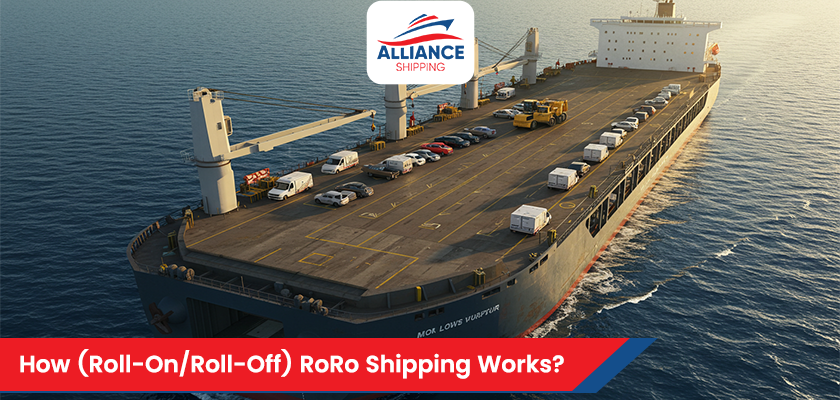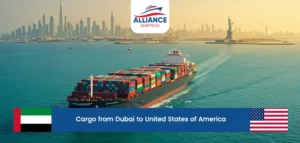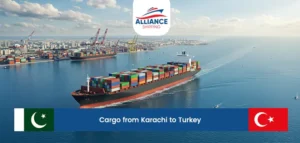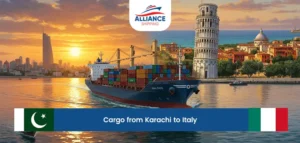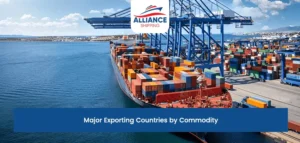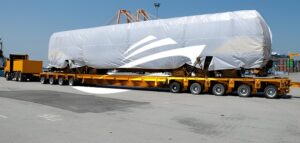RoRo Shipping Works as a simple idea: vehicles and wheeled cargo roll on to a ship and roll off at the destination. RoRo Shipping Works when cars, trucks, buses, trailers, and machinery need to move by sea. The term RoRo makes the loading and unloading fast and direct. As I type this, my fingers tap the keyboard, and the mouse clicks between pictures of ships and ramps. That small rhythm helps me explain how RoRo Shipping Works in plain words.
RoRo vessels have wide ramps and decks with lanes for vehicles. Crew and port staff guide each unit into place and secure it for the voyage. The process feels hands-on: you hear engines, the creak of ramps, and the soft thud of wheels settling. This method keeps handling low and reduces damage.
In this guide, Alliance Shipping will explain why RoRo is chosen, how booking and check-in work, what happens on the ship, and what to expect at arrival. If you want a clear, step-by-step view of RoRo Shipping Works, read on with simple notes and short checks.
How RoRo Shipping Works: Simple Overview
RoRo Shipping Works by using special ships built for vehicles. These ships have large doors and ramps that reach the quay. Vehicles drive on and drive off under their own power or on trailers. The layout inside is like multi-level parking with marked lanes and tie-down points.
Ports prepare parking spots and inspect each vehicle before boarding. Staff check documents, measure height and weight, and note fuel levels. Drivers or haulers then drive the vehicles up the ramp and follow lane markings to their assigned space.
A secure lashing system holds each vehicle in place. Cradles, straps, and wheel chocks prevent movement in storms. The crew checks lashings usually before sailing and after rough weather. While at sea, access to stacked decks is limited for safety.
RoRo Shipping Works well for moving many vehicles at once. It cuts handling steps compared to container shipping. It is also faster for loading and unloading, which helps schedules stay tight and costs predictable. Many car makers and logistics firms choose RoRo for these reasons.
Types of RoRo Vessels and Services
RoRo Shipping Works across different vessel types and service styles. Some ships are pure car carriers with many decks and internal ramps. These pure car carriers are designed to park cars in rows across several levels. Other vessels are multipurpose RoRo ships that can carry trailers, containers on deck, and heavy gear secured to the floor. There are short-sea RoRo ferries that run regular routes and longer ocean RoRo ships that sail across oceans.
Service types vary too. Some lines offer “lift-on/lift-off” options for heavy lifts, while most RoRo relies on rolling. Special services include enclosed deck options for extra protection, and terminal-to-terminal moves that include customs handling. For manufacturers, RoRo liner services with fixed schedules help plan production flows.
Choosing the right vessel type matters. If you ship agricultural or construction machinery, you need a multipurpose RoRo with strong deck strength. If you ship new cars, an enclosed car carrier reduces sun and sea spray exposure. When planning, ask the carrier about deck heights, ramp angles, and whether a lift is available for heavy loads.
RoRo Shipping Works better when the vessel and service fit the cargo type. The right match saves money and lowers the chance of delay or damage.
Step-by-Step: How RoRo Shipping Works
Step No 1: Booking and Documentation
To start, book space with a carrier or an agent. The booking should list the vehicle make, model, weight, and dimensions. You must provide registration details and owner contacts. For special cargo, note lifting points and declared values for insurance.
Key Documents:
- Bill of lading (transport contract)
- Export or customs declarations
- Vehicle registration and ID
- Insurance certificate and declared value
- Any special permits or certificates
Paperwork often includes a bill of lading, export declaration, and any certificates needed by the destination. Keep digital copies and a printed set with the driver. I usually type booking notes and save screenshots as I click through booking pages on my screen.
Step No 2: Drop-Off, Check-In, and Inspection
On arrival at the terminal, a gate check confirms identity and booking. Staff perform a short inspection for leaks, loose items, or visible damage. They may ask to reduce fuel to a safe level or to remove batteries if rules require it. Drivers will be guided to the ramp and told the order of loading.
Step No 3: Loading and Securing on Board
Vehicles drive up the ramp and are placed on assigned lanes. Deck officers balance the ship by placing loads across decks and fore-aft lines. Once parked, the crew secures each vehicle with straps, blocks, and chocks to stop movement. Safety checks are done before the ship leaves port. This is how RoRo Shipping Works in practice.
Step No 4: Transit, Unloading, and Delivery
While at sea, crew inspect lashings and the ship’s stability. On arrival, the ramp lowers and vehicles exit in a planned sequence. Customs or port checks happen before release. After a final document check, haulers collect vehicles for delivery. The process feels planned and quick when all parts work together.
Preparing Vehicles and Cargo for RoRo Shipping
Before you hand over a vehicle, prepare it so RoRo Shipping Works smoothly. Clean the vehicle and remove personal items. Loose items can fall or cause rattle noise during transit. Take photos of all sides and the interior to record condition.
Check fluids, battery, and tires. Many lines request a low tank of fuel and a secure battery. Tape or remove loose trims, car covers, and any soft parts that may flap. Fold mirrors and lock doors. Note any pre-existing scratches in writing and pictures.
For heavy equipment, secure loose parts and use proper skids or frames. Ensure that the machine is safely loaded on a trailer if needed. Declare oversized loads at booking so the terminal can arrange space and ramps.
Label keys and documents with clear contact details. Keep one key with the shipment paperwork or follow the carrier’s instructions. A well-prepared vehicle reduces the chance of delay, extra handling, or damage, and it makes the whole RoRo Shipping Works flow calm and steady.
Costs, Insurance, and Planning for RoRo Shipping Works
Plan costs and insurance early so RoRo Shipping Works without surprises. Costs include freight, port fees, terminal handling, and inland haulage. Carriers may also charge for special handling, oversized loads, or optional services like enclosed deck space.
Insurance protects against weather, fire, theft, or accidents. Standard marine policies may cover basic risks, but check limits and exclusions. For high-value cars, ask about higher cover or special clauses. Keep photos and records to back any claim.
Season and route affect price and speed. Busy seasons or slow ports can delay loading windows. Book early for steady lanes and confirm the schedule with the agent. Keep a checklist and set reminders for key dates like drop-off, sailing, and arrival.
Good packing and clear labeling lower costs and reduce claims. When I plan a shipment, I make a short table on my screen with dates and contacts, then print a copy for the driver. Small steps like this make RoRo Shipping Works with less stress.
Benefits and Limits of RoRo Shipping Works
RoRo Shipping Works offers clear benefits. Loading and unloading are fast, saving time in port. Vehicles experience less lifting, which reduces wear and the chance of minor damage. The method fits many kinds of wheeled cargo and is cost-effective when many units move together.
Another benefit is ease of handling at the origin and destination. Roll-on loading needs fewer cranes and less complex gear. This lowers staffing needs and waiting time. For large auto shipments, RoRo liners provide scheduled services that help with planning and inventory control.
But RoRo has limits. It is best for wheeled, self-powered cargo. Loose pallets, many small boxed items, or non-wheeled goods fit better in containers. Weather can close ramps and delay schedules. Some ports lack RoRo ramps or suitable space for very tall or wide cargo.
Insurance and packing rules still matter. Check fuel limits and battery rules. If your cargo needs pallet-level handling or special dunnage, talk with your carrier to find the best solution. Knowing the limits helps you match goods to RoRo or another shipping mode.
Common Questions and Final Tips
How long does RoRo take? Transit times depend on route and schedule. Loading and unloading are fast, but gate checks and inspections add time. Expect clear windows in your booking.
Is RoRo safe for classic or luxury cars? Yes, when you pick a trusted carrier and request extra care. Ask about options like enclosed decks or reduced handling.
How much does RoRo cost? Prices change by distance, vessel class, and cargo size. Multi-unit shipments often get better rates than single items.
Final tips: keep records, take photos, and confirm all booking details. Label keys and documents and communicate with the terminal. When I prepare a shipment, the keyboard and mouse guide my notes and printouts. That small habit keeps the plan simple and steady.
RoRo Shipping works when you match cargo to the right ship, follow the carrier rules, and prepare with care. It is a clear, practical way to move vehicles, machinery, and other wheeled gear across the sea.
To finish, remember how RoRo Shipping Works: plan, prepare, and pick the right service. When you follow rules, RoRo Shipping Works reliably. Keep your checklists, photos, and contacts — RoRo Shipping Works when care meets the right ship.


